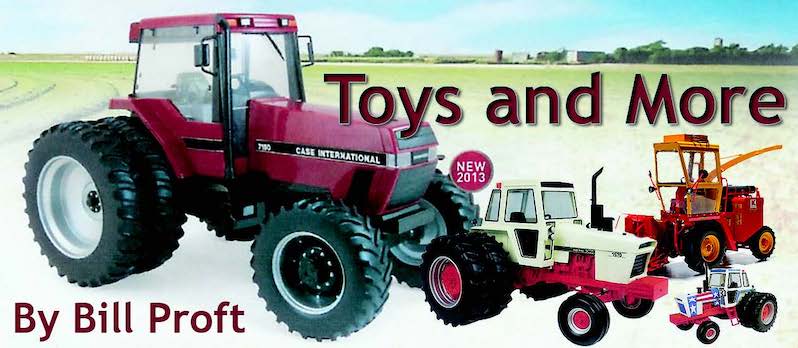By: Bill Proft
January/February 2020 – Classic Farm and Tractor
With only a few issues of Classic Farm and Tractor magazine left to go, I have had to give some serious consideration to exactly what I should cover. I decided that one of the articles needed to be about Tru-Scale toys despite the fact that I have written about some of the items from time to time over the years. There are so many really neat Tru-Scale miniatures that I simply had to mention them yet again.
When my brother, Larry, and I were doing most of our “toy farming” in the 1960s and early 1970s, we had all brands of farm equipment, including several Tru-Scale implements. I wasn’t necessarily enamored with these toys since they were a “generic” brand. They didn’t say “John Deere,” International Harvester” or “Allis-Chalmers” on them and certainly were not painted in those colors. However, they were very realistic in operation. Pulling them on the floor caused aprons, pick-up teeth or reels to move. Elevators could be raised and lowered and they could actually move material. Still, while we enjoyed playing with them, they just weren’t the “name brand” toys.
Our parents grew up on dairy farms in Wisconsin and three of our uncles farmed nearly their entire lives. One of the main stores that they frequented was Mills Fleet Farm. This store has nearly everything, including tires, tractor parts, clothing, snacks, hand tools, bird seed and, of course, toys. I believe that the reason Larry and I had so many Tru-Scale toys is the fact that it was easier to shop at Fleet Farm than make a special trip to a farm machinery dealer. Regardless, we had a nice set of tractors and equipment.
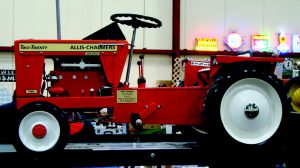
Photo 1 shows the front covers of the two Tru-Scale catalogs that I own. The one on the left is from the late 1950s and the other from the 1960s. The text printed on the cover of each is nearly the same and reads as follows: “The Carter Tru-Scale Line of Metal Miniatures. We urge you to use this folder to acquaint your toy dealer with your preference among the various Tru-Scale toys described herein. Tru-Scale toys are in unquestionable good taste and compliment both the giver and receiver.” That almost sounds as though it was written by a lawyer, doesn’t it? I guess things were much different back then as compared to today.
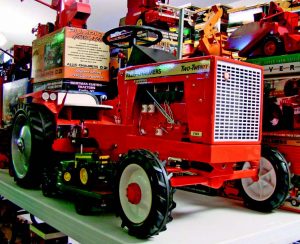
In the next few pictures, I am going to share the Tru-Scale miniatures that I own, all of which are the original toys that Larry and I received about 50 years ago. Photo 2 shows some of our harvesting equipment. On the right is a sickle bar mower in which the cutting bar can be lowered for field operation and raised for transport or storage. Pulling the mower drives a number of gears that actually cause the sickle to move back and forth. In the middle of the picture is a side delivery rake. This toy is really cool in that when it is pulled, the bars and teeth rotate just like the real thing. Even better, there is a crank that can be turned to raise and lower the teeth to accommodate light or heavy crops. The forage harvester on the left is one of two that we have had. I guess both of us received one to minimize arguments. The hitch on this machine can be swung from transport to field position and a PTO shield is included as part of the assembly. Pulling this machine causes the pick-up teeth and auger to rotate. A lever on the right side raises and lowers the pick-up head. On the back is a small crank that allows you to turn the four-blade fan within the blower housing.
Photo 3 includes a wagon with flare box and a two-wheeled trailer. The flare box has a movable end gate at the rear, which slides up and down to allow you to empty whatever you might be hauling. The box is also removable from the wagon. The trailer features a swingdown end gate. It resembles the rear half of a pick-up truck since that is essentially what it is. I will have more on that later.
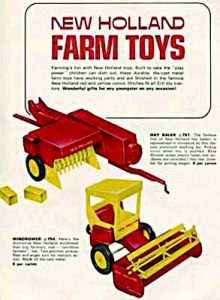
Elevators are shown in Photo 4. These were always fun to play with since they have really neat features. On the right is what I would call a bale elevator. It includes a hitch that can be swung out for transport or under the machine when it is being used. The hopper also swings open or closed. A tiny crank on the side pulls a couple of small strings, which raise the elevator. The shaft of the crank has a flat spot which allows you to lock the height at each one-half turn. A continuous ribbed belt allows you to move material with the turn of a larger crank at the top end of the elevator. On the left is an auger elevator. It has a removable hitch that is lying next to it in the picture. This machine is essentially a clear plastic tube with a silver auger on the inside. There is a small square hole on top of the tube at the lower end and another on the bottom of the tube at the higher end. A metal hopper collects the material to be elevated and a black plastic tube dispenses it at the top. We ran many loads of popcorn through this machine over the years.
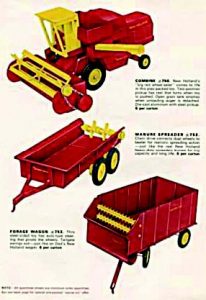
Note that I didn’t show any Tru-Scale boxes. That is because we never bothered to save ours. That’s not a big deal, but I sure wish that I had kept a few of them. Photo 5 shows several examples of new in the box Tru-Scale toys at a recent show. Note that there are items packaged in both fully enclosed and “bubble” cartons. An example of a combine with a fully enclosed carton is shown in Photo 6. In this case, the carton is simply a brown cardboard box with red printing. Photo 7 provides a close-up view of a forage harvester in an opened bubble carton. In this case, red, white and blue graphics were used and the “steel” trademark was also included to signify the fact that these toys were primarily made of steel parts. I find the bubble boxes a little more interesting simply because they allow you to see the toy. The unfortunate fact is that if the clear plastic bubble is in place, it is impossible to remove the toy without decreasing the overall value.
Another facet to Tru-Scale toys is their series of trucks. I have never owned one but I am finding these to be very interesting as well. They manufactured a number of pick-up trucks, dump trucks and semitractor trucks under license from International Harvester. Photo 8 shows three pages from the earlier catalog in Photo 1. The TR-501 pickup is the toy that I was referring to earlier when discussing the twowheeled trailer. Note the similarities in the components. Also note the prices for these models back in the day. The retail price of the pick-up was $2.98. The most expensive truck was the TT-506 dump trailer/tractor at $7.95. That had to be an expensive toy in the late 1950s or early 1960s! Again, all of these trucks had many interesting features including front wheel steering (referred to as “finger tip steering”), opening tail or end gates, and dump bodies, depending on the specific toy. The TR-503 service truck (center, top) is particularly neat with opening storage compartment doors.
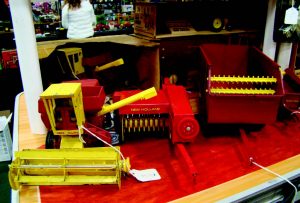
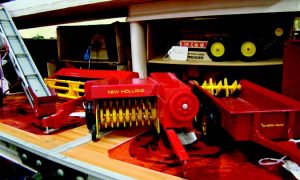
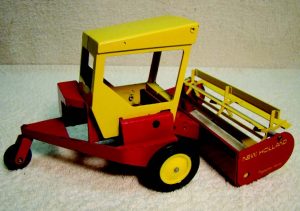
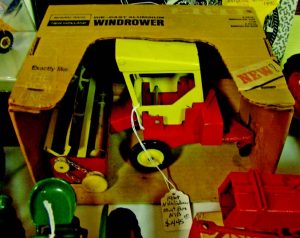
Photo 9 shows some additional Tru-Scale toys that were included in the catalog shown on the right in Photo 1. Here you see the International Scout, sold as a set, or the base truck as a stand-alone item. Also note the “Homelite” chain saw. This is one of those toys in which you pull the recoil handle to wind up a mechanism and then pull the trigger to move the beaded “chain” and create a chain-saw-like sound. For those who collect everything Tru-Scale, these are additional must have items.
Carter Tru-Scale also produced a number of different tractors over the years, most of which resembled International Harvester models.
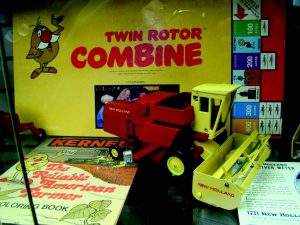
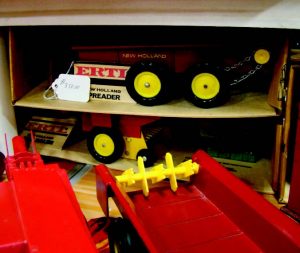
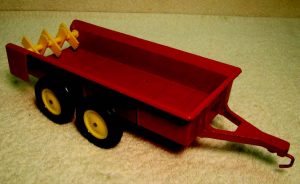
Good, bad or otherwise, they were branded as Tru-Scale tractors with the same type of graphics as the implements. Once again, my brother and I never asked for any of them since a “generic” tractor wouldn’t work on our toy farm. I suppose some International Harvester collectors might be interested in them, but certainly those with Tru-Scale collections would be.
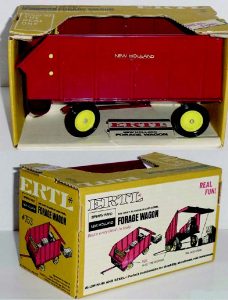
As my collecting interests continue to change and I have a greater appreciation of the farm toys manufactured in the 1950s and 1960s, the Carter Tru-Scale line is something that I have been paying more attention to. The moving parts and realistic appearance are truly great features of these miniatures. The fact that they are manufactured with nearly all-metal construction makes them very durable and able to stand the test of time. I think you can easily argue that at least a couple of pieces would look good in any farm toy collection, especially when hitched to your favorite tractors.
Enjoy.


